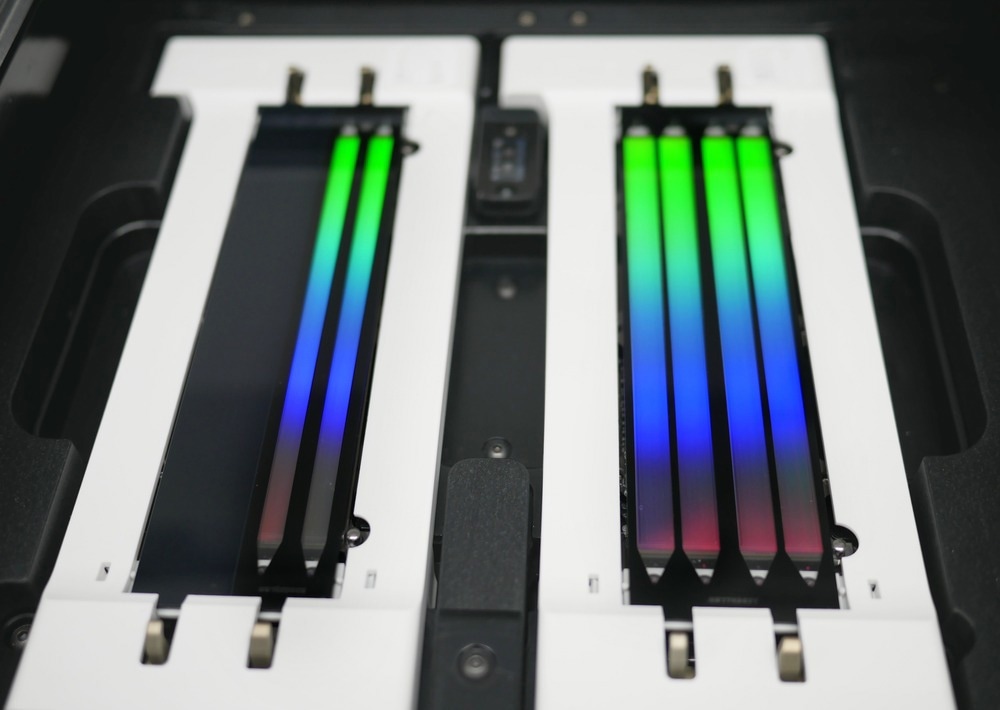Next-generation sequencing (NGS) is a comprehensive method that helps evaluate DNA or RNA sequences to analyze genetic variations useful for disease diagnosis and other biological phenomena.

Image Credit: Elpisterra/Shutterstock.com
In the last two decades, NGS sequencers have significantly improved the speed, throughput, and accuracy of NGS and have revolutionized genomic research related to the environment, medicine, agriculture, and forensic science.
What are NGS Sequencers?
NGS sequencers can analyze hundreds of genes at a time in multiple samples. Furthermore, they can evaluate varied genomic features in a single sequencing run from single nucleotide variants (SNVs). These sequencers can copy structural variants and RNA fusions using a small sample volume. NGS sequencers help accurately detect variants at lower allele frequencies compared to the Sanger sequencing method.
The first major milestone in DNA sequencing was the Human Genome Project, which used first-generation sequencing or Sanger sequencing. This project took thirteen years to complete and cost around $3 billion. In contrast, NGS sequencers entail high-throughput sequencing, which allows DNA/RNA to sequence more quickly, efficiently, and economically.
The fundamental difference between Sanger and NGS is that the former uses capillary electrophoresis, while the latter uses a short-read, massively parallel sequencing technique. NGS technique is highly advantageous compared to the conventional Sanger sequencing technique with respect to operational cost and time.
NGS is also known as the second-generation sequencing method. Recently, NGS sequencers have become a powerful tool in the study of functional genomics.
History and Evolution of NGS Sequencers
NGS sequencers were first commercially introduced in the 21st century, and this method was then known as “massively parallel sequencing”. This name was bestowed because of its ability to sequence a large number of DNA strands simultaneously.
There have been several key moments in the evolution of NGS. In 2000, Lynx Therapeutics Company launched the first NGS technology, which was known as massively parallel signature sequencing (MPSS). This company was later bought by Illumina, an American biotechnology company. Another US-based biotech company, namely, 454 Life Sciences, marketed Roche GS20 in 2004, which was based on new-generation pyrosequencing technology and could generate up to 20 million base pairs.
In 2008, the first human genome sequence was studied using NGS. Another tremendous achievement of Illumina was the marketing of a new NGS sequencer technology called HiSeq X Ten Sequencer. By 2014, Illumina almost monopolized the NGS sequencer industry by holding 70% of the market for DNA sequencers.
Notably, in 2018 Veritas Genetics, a genomics startup company from Massachusetts, offered whole genome sequencing for only $199 for limited customers. The reduction of cost price was considered to be a prominent achievement. In 2022, Illumina marketed a highly sophisticated NovaSeq X Series that can generate more than 20,000 whole genomes per year.
Workflow of a Typical NGS Sequencer
Generally, the NGS sequencer shares the following steps regardless of the instrument technology used. The first step is sample preparation, where the genomic DNA is extracted from varied sample types, such as blood, tissues, and saliva.
After the development of sequencing “library” from samples, the DNA or cDNA is processed into shorter double-stranded fragments (100-800 bps) using different techniques, such as enzyme digestion and physical shearing. Subsequently, PCR-based amplification of defined genetic regions is performed to generate a set of identical clones.
To form fragment libraries, the DNA fragments are ligated to technology-specific adaptor sequences. In some instances, these adaptors contain a unique molecular “barcode”, so each sample can be tagged with a specific DNA sequence. After DNA fragmentation, these are sequenced based on the platform utilized. For instance, pyrosequencing and sequencing by synthesis or ligation can be used.
Scientists ideally prefer sequencing by synthesis because it generates large amounts of genomic DNA, which can help detect genetic alterations, small insertions and deletions (indels), single-nucleotide polymorphisms (SNPs), and structural variations. Bioinformatic tools are used for alignment to reference sequences, quality control, and identification of pathogenic variants.

Image Credit: Elpisterra/Shutterstock.com
Common NGS Sequencer Technologies
To date, many companies have successfully designed several NGS technologies, among which the key NGS sequencers are discussed below:
Illumina (Solexa) Sequencers:
Illumina’s first sequencing platform was purchased from Solexa, which was known as Genome Analyzer. This machine was commercialized in 2007. The Illumina sequencer is based on simultaneously identifying DNA bases, as every single base emits a unique fluorescent signal, and continuously adds them to a nucleic acid chain.
Genome Analyzer was able to generate around 30 base reads per amplified fragment. Its performance was gradually improved by Illumina, such that it was able to rapidly generate over 100 base pairs with an 80-gigabase output.
Illumina’s second NGS sequencer, called HiSeq, was launched in 2010, which was associated with two flow cells. The company continued to upgrade its sequencers and developed HiSeq X10. Illumina commercializes benchtop NGS sequencers, such as the iSeq 100 and the MiniSeq, along with the NextSeq and NovaSeq machines.
Ion Torrent: Proton / PGM Sequencers:
The Ion Torrent NGS sequencer is different from the aforementioned sequencers because it does not measure light. Instead, it measures the direct release of protons (H+). This method is based on the addition of deoxynucleotide triphosphates (dNTP) to a DNA polymer, which releases a proton. Therefore, the Ion Torrent system does not require a camera or light scanner, and the nucleotide incorporation is directly converted into a voltage, which significantly speeds up the process.
A limitation of Ion Torrent is the presence of homopolymers. In the presence of more than ten homopolymers in a row on the template DNA strand, the accuracy of the sequencer is compromised. In addition, this technology is dependent on PCR for DNA amplification. However, the Ion Chef System could be used to automate this step.
The Ion Torrent sequencers are manufactured by Thermo Fisher Scientific. Currently, there are two Ion Torrent sequencers available in the market, namely, the Ion GeneStudio S5 System and the Ion Torrent Genexus System. These sequences are used to study oncology, genetic diseases, human identification (HID), agrigenomics, and human leukocyte antigen (HLA) typing.
Roche 454 Sequencers:
This sequencer is based on pyrosequencing, i.e., detection of pyrophosphate release after nucleotides are incorporated by the polymerase into a new DNA strand, using bioluminescence or light signal. This is an optics-based technique. In 2016, this sequencer was discontinued.
Applications of NGS Sequencers
NGS sequencers can be used to analyze both DNA and RNA samples. These are popularly used in functional genomics. Compared to microarray methods, NGS-based techniques have several advantages, including no requirement of prior knowledge of the genome or genomic features. Since it offers single-nucleotide resolution, it can be used to detect specific genes for a disease or other biological functions.
NGS is used in cancer research, particularly in the development of diagnostics, immune-oncology solutions, and for targeted sequencing related to oncology. NGS sequencers have been used for high-throughput whole viral genome sequencing (e.g., influenza viruses). This technique helps determine viral genome variability and evolution within the host.
NGS sequencers, such as Ion AmpliSeq targeted sequencing technology on the Ion GeneStudio S5 System, have been used in epigenetics and methylation analysis. Thermo Fisher has also launched the Ion AmpliSeq Microbiome Health Research Kit based on NGS assay for comprehensive profiling of microbial diversity in the human gut microbiome in a cost-effective manner.
The NGS-based technique is also used for immune system and inflammation studies. In addition to whole exome sequencing, NGS sequencers are used for targeted DNA and RNA sequencing. Ion Torrent systems provide high sensitivity, scalability, and rapid turnaround time, which is crucial for microbial outbreak investigation research.
Notably, NGS-based assays are used to study reproductive health, particularly for expanded carrier screening and preimplantation genetic testing. In forensic science, this assay is used for human identification. Besides human research, NGS sequencers are also used in plant and animal genotyping applications.
Major Manufacturers of NGS Sequencers
Several major and startup companies, such as Illumina, Agilent Technologies, Thermo Fisher Scientific, Perkin Elmer, QIAGEN, Roche, Bio-Rad Laboratories, Oxford Nanopore Technologies, and Myriad Genetics, produce NGS sequencers.
These companies are constantly improving their product to satisfy consumer demand. Some companies have developed and marketed NGS benchtop platforms, which will increase the use of this technique by many laboratories. For instance, GenapSys’ NGS sequencer is a small desktop-based machine that has been designed for fast and cost-effective processes.
Recently, GenapSys has collaborated with Twist Bioscience to improve sequence platforms. Such collaborations will positively improve the SARS-CoV-2 (COVID-19) tracking, cancer diagnostics, and drug discovery.
Despite the increase in the competition, the NGS sequencer market is still dominated by Illumina, which has successfully reduced the cost of DNA sequencing from billions to less than $1,000 within two decades. The recently launched Ion GeneStudio S5 Series by Thermo Fisher has shown significant promise. At present, all the companies are working tirelessly to reduce the price of NGS sequencers even further.
Sources:
What is Next-Generation Sequencing (NGS)? (2023) [Online] Thermo Fisher Scientific. Available at: www.thermofisher.com/.../what-is-next-generation-sequencing.html
Next Generation Sequencers. (2023) [Online] Biocompare. Available at: www.biocompare.com/.../.
What is Next Generation DNA Sequencing? (2023) [Online] EMBL-EBI. Available at: www.ebi.ac.uk/.../.
Next Generation Sequencing. (2023) [Online] Roche.Available at: sequencing.roche.com/.../next-generation-sequencing.html.
Mobley, I. (2021) A Brief History of Next Generation Sequencing. [Online] Front Line Genomics. Available at: frontlinegenomics.com/.../.
Mobley, I. (2021) DNA Sequencing: How to Choose the Right Technology. [Online] Front Line Genomics. Available at: frontlinegenomics.com/.../.